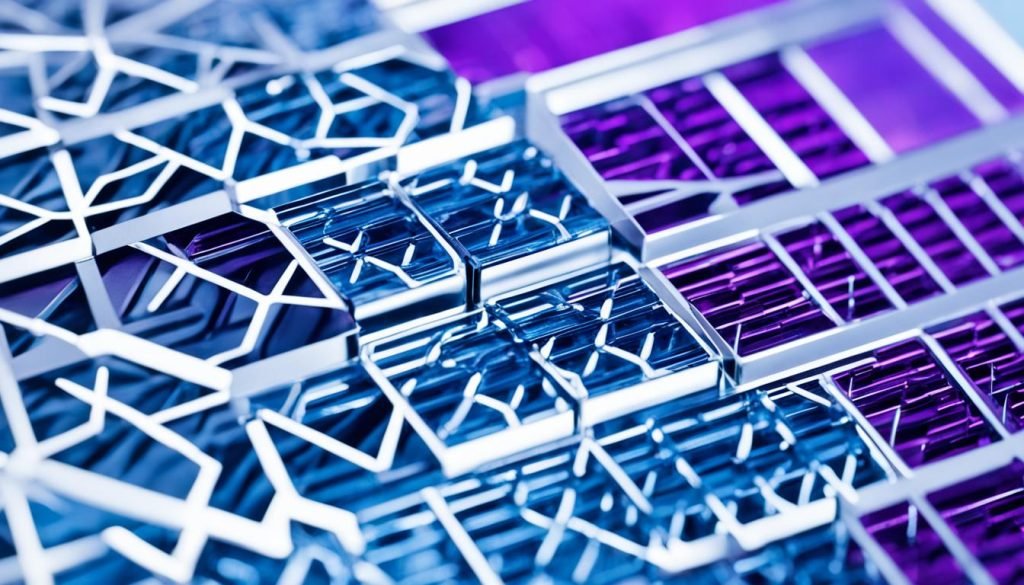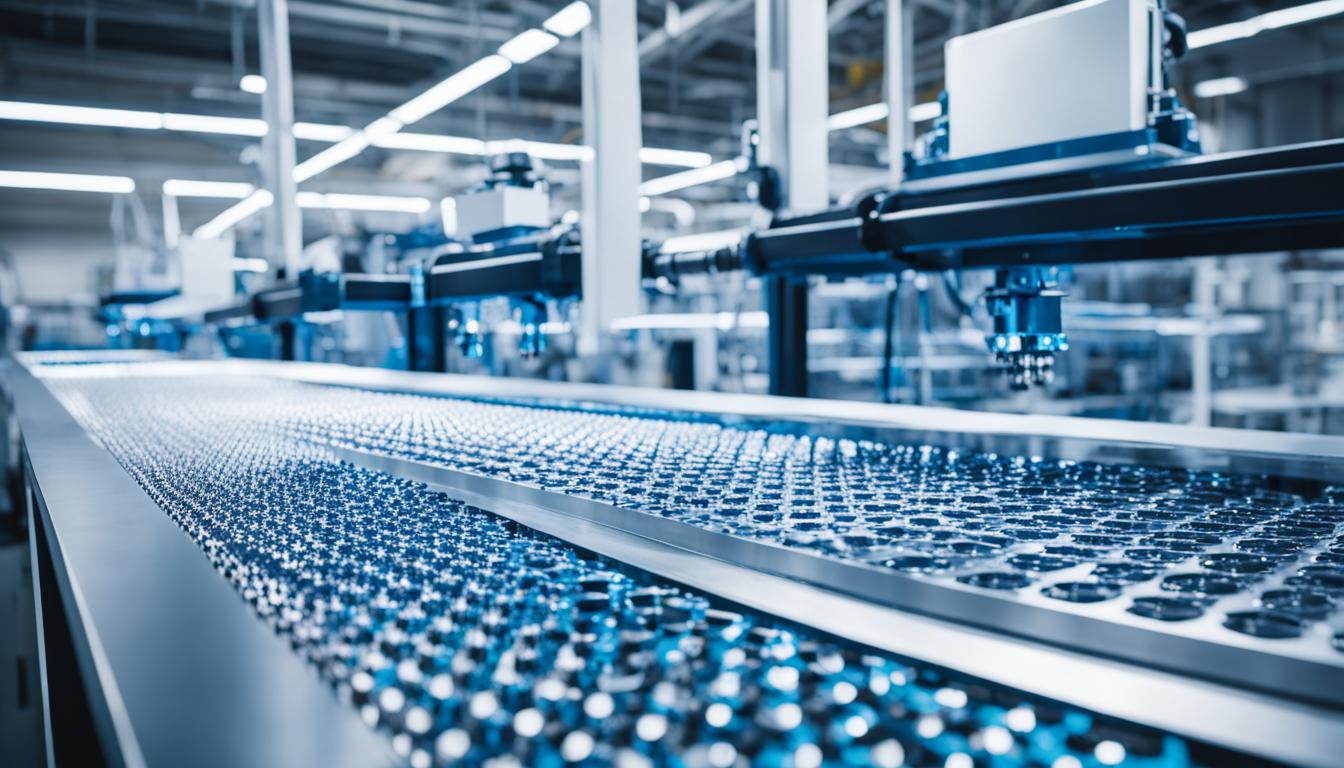Did you know that advanced materials in manufacturing have the potential to transform industries across the globe? From aerospace to automotive, from defense to construction, these cutting-edge materials are paving the way for the future of manufacturing. With their high-performance properties and innovative manufacturing techniques, advanced materials are revolutionizing traditional industries and opening up new possibilities for next-generation technologies.
Key Takeaways:
- Advanced materials in manufacturing offer significant advantages in terms of performance, energy savings, and improved safety.
- Composite Metal Foam (CMF) is a game-changing material that is lightweight, high-performance, and versatile.
- Advanced Materials Manufacturing (AMM) is the sole manufacturer and supplier of CMF, making it available in global markets.
- The multidisciplinary approach in advanced materials research drives innovation and breakthroughs in materials science and manufacturing.
- State-of-the-art facilities and centers, like the Lawrence Livermore National Laboratory, provide the infrastructure for advanced materials research and development.
Composite Metal Foam: A Game-Changing Material
Composite Metal Foam (CMF) is a groundbreaking development in the field of metallic materials. It is a lightweight metallic material that offers enhanced performance and versatility. CMF is designed to have the strength of steel while being as lightweight as aluminum. Its innovative composition consists of a combination of hollow metal spheres trapped inside a metal matrix, which can be made from various metals and alloys.
The unique structure of CMF provides excellent chemical and physical performance tailored for each application. This innovative material exhibits exceptional properties that make it ideal for a wide range of industries.
One of CMF’s notable features is its exceptional impact energy absorption capabilities. Industries that prioritize safety, such as aerospace and automotive, can benefit greatly from CMF’s ability to absorb and dissipate impact energy, thereby reducing the risk of injury or damage. This improved level of safety can potentially save lives and resources.
CMF’s versatility extends beyond safety. It also offers superior fire protection and radiation shielding properties. These properties make it a valuable material for applications in industries where fire resistance and radiation protection are crucial.
Furthermore, CMF’s lightweight nature contributes to energy savings, as it requires less energy to produce and transport compared to heavier traditional materials. Using CMF in different applications can lead to reduced fuel consumption and less energy-intensive processes, resulting in a greener and more sustainable environment.
As industries worldwide strive for more sustainable practices, CMF provides environmental benefits. Its lightweight nature and energy-efficient production contribute to a reduced carbon footprint and overall environmental impact.
In conclusion, Composite Metal Foam (CMF) is an innovative and game-changing material that offers a combination of lightweight design, enhanced safety, and superior properties such as fire protection and radiation shielding. Its unique composition and versatile applications make it an ideal choice for advanced manufacturing solutions in various industries.
Advanced Materials Manufacturing’s Contribution
Advanced Materials Manufacturing (AMM) is a leader in materials innovation, particularly with its groundbreaking Composite Metal Foam (CMF) technology. By providing lightweight materials, AMM is making significant contributions to energy savings, environmental benefits, and improved safety across various industries.
CMF has revolutionized the way industries operate, thanks to its remarkable properties. Not only is it lightweight, but it also boasts exceptional impact energy absorption, fire protection, and radiation shielding capabilities. These features make CMF a game-changing material for applications in sectors such as aerospace, automotive, defense, and construction.
In the aerospace industry, the use of CMF enables significant weight reduction in aircraft, resulting in reduced fuel consumption and lower emissions. This not only translates into cost savings but also contributes to a more sustainable future by reducing the carbon footprint of air travel.
When applied in the automotive sector, CMF technology allows for the production of lighter vehicles. This leads to improved fuel efficiency, thereby reducing the environmental impact of transportation. Furthermore, CMF’s enhanced safety features provide added protection to passengers in the event of an accident.
In the defense sector, CMF’s unique properties make it an ideal material for armor systems and protective structures. Its ability to absorb impact energy and withstand fire offers increased protection for military personnel, vehicles, and critical infrastructure.
CMF also finds applications in the construction industry. Its lightweight nature allows for the construction of more efficient structures, reducing material consumption and energy expenditure during the building process. Additionally, CMF’s superior fire protection properties enhance the safety of buildings, protecting lives and property.
AMM understands the global demand for advanced materials and is committed to making CMF available in global markets. By expanding access to CMF technology, AMM aims to facilitate its uptake across industries worldwide, driving innovation, and transformation on a global scale.
Overall, Advanced Materials Manufacturing’s commitment to pushing the boundaries of materials innovation through CMF technology is delivering substantial benefits, leading to energy savings, environmental advantages, and improved safety across global markets.
Benefits of CMF Technology:
| Industry | Benefits |
|---|---|
| Aerospace | • Reduced fuel consumption and emissions • Enhanced safety features |
| Automotive | • Improved fuel efficiency • Environmental sustainability |
| Defense | • Enhanced protection for personnel and infrastructure |
| Construction | • Lightweight structures • Superior fire protection |
Multidisciplinary Approach to Advanced Materials and Manufacturing
When it comes to advanced materials and manufacturing, a multidisciplinary approach is essential in tackling the technological challenges faced by various industries. At Advanced Materials Manufacturing, our team of scientists and engineers are at the forefront of developing innovative materials with tailored properties to meet the diverse needs of different applications.
Advanced materials and manufacturing necessitate a holistic approach, incorporating expertise from various fields to drive innovation and overcome complex obstacles.
In our pursuit of advancements, we focus on a wide range of areas including:
- Innovative Materials: Our multidisciplinary team endeavors to develop materials that possess exceptional characteristics. These materials are designed for energy absorption, dissipation, generation, and storage, enabling efficient and sustainable solutions in industries such as automotive, aerospace, and renewable energy.
- Bioinspired Structures: Taking inspiration from nature, we create bioinspired structures that mimic the efficiency and resilience found in biological systems. These structures hold immense potential for applications such as drug delivery, tissue engineering, and biomimetic design.
- Advanced Optics: Our experts work on developing materials with advanced optical properties for applications in satellites, telescopes, and other optical systems. These materials enable high-performance light manipulation and enhance the quality and precision of optical devices.
- Quantum Materials: We delve into the realm of quantum materials, exploring their unique properties and potential applications. These materials have the potential to revolutionize fields such as computing, communication, and sensing.
- Components for Extreme Environments: Our team focuses on developing materials and components that can withstand and perform effectively in extreme environments such as high temperatures, corrosive conditions, and extreme pressures.
Through this multidisciplinary approach, Advanced Materials Manufacturing enhances performance, functionality, and flexibility in design-enabled manufacturing techniques. By combining expertise from various disciplines, we are able to deliver cutting-edge solutions that push the boundaries of what is possible in advanced materials and manufacturing.
Image: Multidisciplinary Approach to Advanced Materials and Manufacturing – Exploring the intersection of various disciplines to drive innovation in advanced materials and manufacturing.
Leaders in Advanced Materials Research
When it comes to advanced materials research, Advanced Materials Manufacturing (AMM) is home to a team of exceptional scientists and engineers who are at the forefront of innovation in the field. Their expertise and multidisciplinary approach drive breakthroughs in materials science and manufacturing.
Among the leaders in advanced materials research at AMM is Sal Baxamusa, the Deputy Program Manager for Target Fabrication. Sal’s expertise and contributions have played a key role in advancing the development of advanced materials and technologies.
Another key figure in the field is Eric Duoss, the Director of the Center for Engineered Materials and Manufacturing. With his vast knowledge and experience, Eric spearheads research and development efforts, ensuring AMM’s continued leadership in advanced materials research.
Jeremy Feaster, an Electrochemical Engineer, is instrumental in pushing the boundaries of materials science. His expertise in electrochemistry contributes to the development of new materials and technologies for energy storage and conversion.
Simon Pang, the Deputy Group Leader for Materials for Energy and Climate Security, is renowned for his work in materials design and innovation. Simon’s research focuses on developing materials that address the energy and environmental challenges of today.
These accomplished scientists and engineers, along with their colleagues at AMM, collaborate closely with the renowned Lawrence Livermore National Laboratory to bring cutting-edge materials and advanced manufacturing techniques to life. Together, they continue to push the boundaries of materials science and pave the way for transformative technologies.
Key Figures in Advanced Materials Research
| Scientist/Engineer | Role |
|---|---|
| Sal Baxamusa | Deputy Program Manager for Target Fabrication |
| Eric Duoss | Director of the Center for Engineered Materials and Manufacturing |
| Jeremy Feaster | Electrochemical Engineer |
| Simon Pang | Deputy Group Leader for Materials for Energy and Climate Security |

Focus Areas in Advanced Materials Research
The focus areas in advanced materials research encompass a wide range of applications. Scientists and engineers are constantly pushing the boundaries of material science to develop innovative solutions that drive progress in various industries. Some key focus areas include:
Materials for Energy Storage and Conversion
Advanced materials play a vital role in developing efficient energy storage and conversion systems. This includes the creation of advanced batteries and renewable energy technologies. By exploring new materials, researchers aim to improve the performance, durability, and sustainability of energy storage and conversion devices.
Electric, Optic, and Magnetic Materials
Innovative electric, optic, and magnetic materials are essential for emerging technologies and communication systems. Researchers are focused on developing materials that are highly conductive, have enhanced optical properties, and exhibit magnetic characteristics suitable for a range of applications, from electronics to telecommunications.
Structural Materials
Structural materials that can withstand extreme conditions are critical for industries such as aerospace, automotive, and construction. Researchers are working on developing lightweight yet strong materials that can withstand high temperatures, corrosive environments, and mechanical stresses, ensuring the safety and reliability of structures and components.
Additive Manufacturing
Additive manufacturing, also known as 3D printing, is an advanced manufacturing process that allows for precise and complex designs with customized functionalities. Researchers are investigating new materials and techniques to expand the capabilities of additive manufacturing, enabling the production of intricate and high-performance components.
Bio-Technology, Medicine, and Life Science
Advanced materials have transformative applications in the fields of bio-technology, medicine, and life sciences. Researchers are developing biomaterials that are compatible with the human body, enabling breakthroughs in medical treatments, drug delivery systems, tissue engineering, and diagnostic devices. These materials offer improved biocompatibility, bioactivity, and controlled release properties, enhancing patient outcomes and quality of life.
These focus areas are driving advancements in advanced materials research, leading to breakthroughs that have the potential to transform industries and improve lives.

Cutting-Edge Material Design and Characterization
Advanced materials research involves cutting-edge material design and characterization. Scientists and engineers work on developing materials with tailored properties through innovative design processes. This involves identifying the specific requirements of each application and designing materials that meet those needs.
Material design involves selecting the appropriate composition, structure, and morphology to optimize performance. Whether it’s improving strength, durability, conductivity, or other properties, designers carefully choose the materials and their arrangements to achieve the desired outcomes.
Material characterization techniques are then employed to understand and analyze the structure and performance of these materials. Advanced characterization techniques such as X-ray diffraction, scanning electron microscopy, and atomic force microscopy provide valuable insights into the material’s physical and chemical properties.
Manufacturing processes play a crucial role in bringing these materials to life. Methods such as casting, forging, extrusion, and additive manufacturing convert the designed materials into devices and components that can be integrated into various applications.
In order to optimize designs and manufacturing processes, materials modeling is utilized. By using computer simulations and mathematical models, engineers can predict the behavior of materials under different conditions and optimize the design accordingly.
Material design and characterization, along with advanced manufacturing processes and materials modeling, are essential for developing innovative materials that drive advancements in various industries.
For example, in aerospace applications, lightweight and high-strength materials are required to improve fuel efficiency. By carefully designing materials with optimized properties, engineers can develop alloys and composites that provide the necessary strength while reducing weight.
Similarly, in the field of electronics, advanced materials with specific electrical properties are crucial for the development of high-performance devices. Through material design and characterization, engineers can create materials with enhanced conductivity or dielectric properties, enabling the production of faster and more efficient electronic components.
Overall, the combination of material design, characterization, manufacturing processes, and materials modeling is instrumental in advancing the field of advanced materials research. By continuously pushing the boundaries of what is possible, scientists and engineers are driving innovation and revolutionizing industries.
| Advanced Characterization Techniques | Manufacturing Processes | Materials Modeling |
|---|---|---|
| X-ray diffraction | Casting | Computer simulations |
| Scanning electron microscopy | Forging | Mathematical models |
| Atomic force microscopy | Extrusion |
State-of-the-Art Facilities and Centers
Advanced materials and manufacturing research are conducted in state-of-the-art facilities and centers. Lawrence Livermore National Laboratory is home to several world-class facilities and centers dedicated to advancing the field. The Centers for Engineered Materials and Manufacturing focus on research and development in advanced materials and manufacturing, bringing together experts from various disciplines. These facilities and centers provide the necessary infrastructure and resources for researchers to tackle the most complex challenges in advanced materials and manufacturing.
Conclusion
Advanced Materials in Manufacturing are revolutionizing industries through the development and utilization of cutting-edge materials and innovative manufacturing solutions. One such game-changing material is Composite Metal Foam (CMF), which provides a lightweight yet high-performance alternative to traditional materials. CMF offers significant advantages such as energy savings, environmental sustainability, and improved safety.
With a multidisciplinary approach and access to state-of-the-art facilities, Advanced Materials Manufacturing is at the forefront of advanced materials research. By focusing on material design, characterization, and advanced manufacturing techniques, they drive advancements across diverse sectors such as aerospace, automotive, defense, and construction.
The next-generation materials developed by Advanced Materials Manufacturing continue to transform industries and pave the way for future advancements in manufacturing. By pushing the boundaries of what is possible, they are shaping a new era of advanced materials and manufacturing that will redefine industries and contribute to a more sustainable and efficient future.
FAQ
What is Composite Metal Foam (CMF)?
Composite Metal Foam (CMF) is a high-performance and lightweight metallic material that consists of hollow metal spheres trapped inside a metal matrix. It offers the strength of steel while being as lightweight as aluminum.
What are the advantages of CMF?
CMF is 3 times lighter weight than traditional materials, has 100 times higher impact energy absorption, 7+ times longer fire protection, and 4 times higher X-ray and neutron radiation shielding. It provides significant benefits in terms of energy savings, environmental sustainability, and improved safety.
What industries can benefit from CMF?
CMF is ideal for industries that require enhanced safety measures, such as aerospace, automotive, defense, and construction.
What is the role of Advanced Materials Manufacturing in CMF?
Advanced Materials Manufacturing (AMM) is the sole manufacturer and supplier of CMF. They are making it available in global markets, contributing to its widespread adoption across industries.
What is the multidisciplinary approach in advanced materials and manufacturing?
The multidisciplinary approach in advanced materials and manufacturing involves scientists and engineers developing innovative materials with tailored properties for various applications. This includes energy absorption, dissipation, generation, and storage, bioinspired structures, advanced optics, and components for extreme environments.
Who are the leaders in advanced materials research?
Advanced Materials Manufacturing boasts a team of leading scientists and engineers. Sal Baxamusa is the Deputy Program Manager for Target Fabrication, Eric Duoss is the Director of the Center for Engineered Materials and Manufacturing, Jeremy Feaster is an Electrochemical Engineer, and Simon Pang is the Deputy Group Leader for Materials for Energy and Climate Security.
What are the focus areas in advanced materials research?
The focus areas in advanced materials research include materials for energy storage and conversion, electric, optic, and magnetic materials, structural materials, additive manufacturing techniques, and applications in bio-technology, medicine, and life sciences.
What is the significance of material design and characterization in advanced materials?
Material design and characterization are crucial in advanced materials as they involve developing materials with tailored properties and analyzing their structure and performance. Advanced characterization techniques and materials modeling are used to simulate and predict the behavior of materials, enabling optimal design and manufacturing techniques.
What are the state-of-the-art facilities and centers in advanced materials research?
Lawrence Livermore National Laboratory houses several world-class facilities and centers dedicated to advanced materials and manufacturing research. The Centers for Engineered Materials and Manufacturing bring together experts from various disciplines and provide the infrastructure and resources needed for cutting-edge research.







